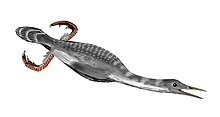
Back طائر الغرب Arabic Hesperornis Catalan Hesperornis Czech Hesperornito Esperanto Hesperornis Spanish Hesperornis Basque باخترمرغ Persian Hesperornis Finnish Hesperornis French הספראורניס HE
| Hesperornis | |
|---|---|

| |
| Restored skeleton of H. regalis in diving posture at the American Museum of Natural History | |

| |
| Life reconstruction of H. regalis in diving posture | |
| Scientific classification | |
| Domain: | Eukaryota |
| Kingdom: | Animalia |
| Phylum: | Chordata |
| Clade: | Dinosauria |
| Clade: | Saurischia |
| Clade: | Theropoda |
| Clade: | Avialae |
| Clade: | †Hesperornithes |
| Family: | †Hesperornithidae |
| Genus: | †Hesperornis Marsh, 1872 |
| Type species | |
| †Hesperornis regalis Marsh, 1872
| |
| Species | |
|
†H. regalis Marsh, 1872 | |
| Synonyms | |
|
Lestornis Marsh, 1876 | |
Hesperornis (meaning "western bird") is a genus of cormorant-like Ornithuran that spanned throughout the Campanian age, and possibly even up to the early Maastrichtian age, of the Late Cretaceous period.[1][2] One of the lesser-known discoveries of the paleontologist O. C. Marsh in the late 19th century Bone Wars, it was an early find in the history of avian paleontology. Locations for Hesperornis fossils include the Late Cretaceous marine limestones from Kansas and the marine shales from Canada. Nine species are recognised, eight of which have been recovered from rocks in North America and one from Russia.
- ^ Alyssa Bell; Kelly J. Irwin; Leo Carson Davis (2015). "Hesperornithiform birds from the Late Cretaceous (Campanian) of Arkansas, USA". Transactions of the Kansas Academy of Science. 118 (3–4): 219–229. doi:10.1660/062.118.0305. JSTOR 24887762. S2CID 83921936.
- ^ Cite error: The named reference
Hills99was invoked but never defined (see the help page).
© MMXXIII Rich X Search. We shall prevail. All rights reserved. Rich X Search